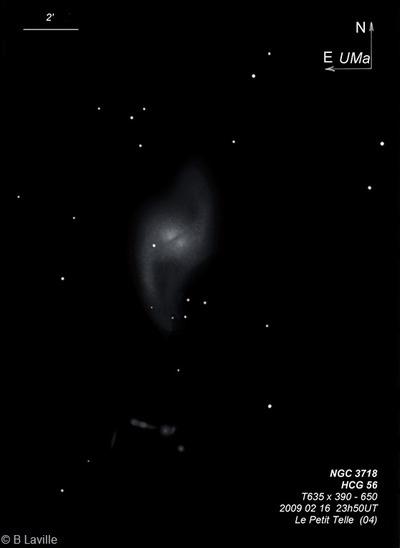
William Herschel discovered NGC 3718 = H I-221 = h908 on 12 Apr 1789 (sweep 919) and recorded "pB or cB, R, vgmbM, about 3' dia." His position is accurate.
Bindon Stoney, observing on 27 Jan 1852 with LdR's 72", commented "found a neb strongly mottled, with stars inv." A later observation in 1868 questioned if it was a double nebula.
300/350mm - 13.1" (3/24/84): fairly bright, fairly large, broad concentration, almost round. Double star h2574 = mag 11/11 at 35" separation is 2.2' SSW of center. NGC 3729 lies 12' ENE. Member of the LGG 241 or UMa NED1 group, probably a subgroup of the NGC 3992 (M109) group. The galaxy chain HCG 56 = UGC 6527 = VV 150 lies 7' S.
900/1200mm - 48" (4/4/11): NGC 3718 is a very striking, distorted system with sweeping arms emanating from an oval main body crossed by a curving dust lane (reminiscent of Centaurus A). At 375x it appeared very bright, very large, elongated ~5:2 N-S (including arms), ~6.5'x2.5', contains a bright round core. A star is at the east edge of the core. The main body is nearly split by a dust lane or gap oriented NW to SE, which is particularly evident on the NW side as a lane. A spiral arm (perhaps 0.4' wide) is attached at the NW end and gently curves counterclockwise towards the NE. The surface brightness is fairly low and the arm or wing dims as it extends nearly to the west of a mag 11 star located 4' NNE of center. The dust on the south side of the core covers a larger region and is concentrated just west of where the southern arm begins to emerge on the southeast end. A fairly low surface brightness arm spreads south (wider than the northern arm), passing east of a wide mag 11 pair at 33" separation. The overall visual impression is that the "arms" are really tidal tails being drawn out from a past interaction as the central body looks more like the merger of two galaxies resulting in the warped dust lane and "S" shaped body. All five members of HCG 56 (located 7' S) were easily resolved.
Notes by Steve Gottlieb